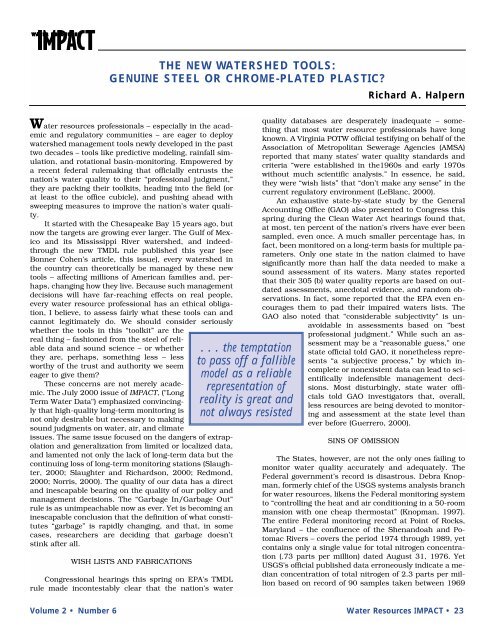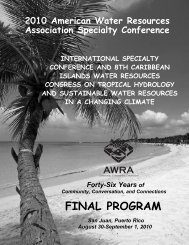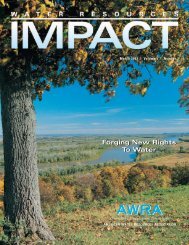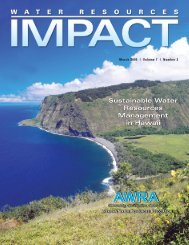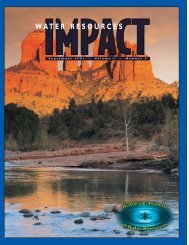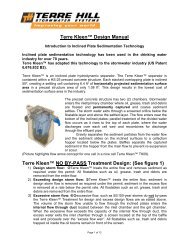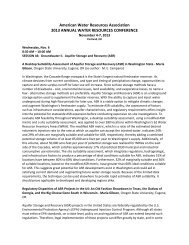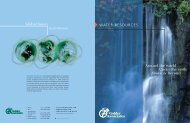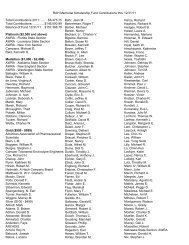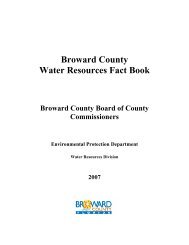N ovember 2 0 0 0 ⢠V olume 2 ⢠N umber 6 - American Water ...
N ovember 2 0 0 0 ⢠V olume 2 ⢠N umber 6 - American Water ...
N ovember 2 0 0 0 ⢠V olume 2 ⢠N umber 6 - American Water ...
Create successful ePaper yourself
Turn your PDF publications into a flip-book with our unique Google optimized e-Paper software.
THE NEW WATERSHED TOOLS:<br />
GENUINE STEEL OR CHROME-PLATED PLASTIC?<br />
Richard A. Halpern<br />
<strong>Water</strong> resources professionals – especially in the academic<br />
and regulatory communities – are eager to deploy<br />
watershed management tools newly developed in the past<br />
two decades – tools like predictive modeling, rainfall simulation,<br />
and rotational basin-monitoring. Empowered by<br />
a recent federal rulemaking that officially entrusts the<br />
nation's water quality to their “professional judgment,”<br />
they are packing their toolkits, heading into the field (or<br />
at least to the office cubicle), and pushing ahead with<br />
sweeping measures to improve the nation’s water quality.<br />
It started with the Chesapeake Bay 15 years ago, but<br />
now the targets are growing ever larger. The Gulf of Mexico<br />
and its Mississippi River watershed, and indeedthrough<br />
the new TMDL rule published this year (see<br />
Bonner Cohen’s article, this issue), every watershed in<br />
the country can theoretically be managed by these new<br />
tools – affecting millions of <strong>American</strong> families and, perhaps,<br />
changing how they live. Because such management<br />
decisions will have far-reaching effects on real people,<br />
every water resource professional has an ethical obligation,<br />
I believe, to assess fairly what these tools can and<br />
cannot legitimately do. We should consider seriously<br />
whether the tools in this “toolkit” are the<br />
real thing – fashioned from the steel of reliable<br />
data and sound science – or whether<br />
they are, perhaps, something less – less<br />
worthy of the trust and authority we seem<br />
eager to give them?<br />
These concerns are not merely academic.<br />
The July 2000 issue of IMPACT, ("Long<br />
Term <strong>Water</strong> Data") emphasized convincingly<br />
that high-quality long-term monitoring is<br />
not only desirable but necessary to making<br />
sound judgments on water, air, and climate<br />
issues. The same issue focused on the dangers of extrapolation<br />
and generalization from limited or localized data,<br />
and lamented not only the lack of long-term data but the<br />
continuing loss of long-term monitoring stations (Slaughter,<br />
2000; Slaughter and Richardson, 2000; Redmond,<br />
2000; Norris, 2000). The quality of our data has a direct<br />
and inescapable bearing on the quality of our policy and<br />
management decisions. The “Garbage In/Garbage Out”<br />
rule is as unimpeachable now as ever. Yet is becoming an<br />
inescapable conclusion that the definition of what constitutes<br />
“garbage” is rapidly changing, and that, in some<br />
cases, researchers are deciding that garbage doesn’t<br />
stink after all.<br />
WISH LISTS AND FABRICATIONS<br />
Congressional hearings this spring on EPA's TMDL<br />
rule made incontestably clear that the nation’s water<br />
. . . the temptation<br />
to pass off a fallible<br />
model as a reliable<br />
representation of<br />
reality is great and<br />
not always resisted<br />
quality databases are desperately inadequate – something<br />
that most water resource professionals have long<br />
known. A Virginia POTW official testifying on behalf of the<br />
Association of Metropolitan Sewerage Agencies (AMSA)<br />
reported that many states’ water quality standards and<br />
criteria “were established in the1960s and early 1970s<br />
without much scientific analysis.” In essence, he said,<br />
they were “wish lists” that “don’t make any sense” in the<br />
current regulatory environment (LeBlanc, 2000).<br />
An exhaustive state-by-state study by the General<br />
Accounting Office (GAO) also presented to Congress this<br />
spring during the Clean <strong>Water</strong> Act hearings found that,<br />
at most, ten percent of the nation’s rivers have ever been<br />
sampled, even once. A much smaller percentage has, in<br />
fact, been monitored on a long-term basis for multiple parameters.<br />
Only one state in the nation claimed to have<br />
significantly more than half the data needed to make a<br />
sound assessment of its waters. Many states reported<br />
that their 305 (b) water quality reports are based on outdated<br />
assessments, anecdotal evidence, and random observations.<br />
In fact, some reported that the EPA even encourages<br />
them to pad their impaired waters lists. The<br />
GAO also noted that “considerable subjectivity” is unavoidable<br />
in assessments based on “best<br />
professional judgment.” While such an assessment<br />
may be a “reasonable guess,” one<br />
state official told GAO, it nonetheless represents<br />
“a subjective process,” by which incomplete<br />
or nonexistent data can lead to scientifically<br />
indefensible management decisions.<br />
Most disturbingly, state water officials<br />
told GAO investigators that, overall,<br />
less resources are being devoted to monitoring<br />
and assessment at the state level than<br />
ever before (Guerrero, 2000).<br />
SINS OF OMISSION<br />
The States, however, are not the only ones failing to<br />
monitor water quality accurately and adequately. The<br />
Federal government’s record is disastrous. Debra Knopman,<br />
formerly chief of the USGS systems analysis branch<br />
for water resources, likens the Federal monitoring system<br />
to “controlling the heat and air conditioning in a 50-room<br />
mansion with one cheap thermostat” (Knopman, 1997).<br />
The entire Federal monitoring record at Point of Rocks,<br />
Maryland – the confluence of the Shenandoah and Potomac<br />
Rivers – covers the period 1974 through 1989, yet<br />
contains only a single value for total nitrogen concentration<br />
(.73 parts per million) dated August 31, 1976. Yet<br />
USGS’s official published data erroneously indicate a median<br />
concentration of total nitrogen of 2.3 parts per million<br />
based on record of 90 samples taken between 1969<br />
V<strong>olume</strong> 2 • N<strong>umber</strong> 6 <strong>Water</strong> Resources IMPACT • 23


